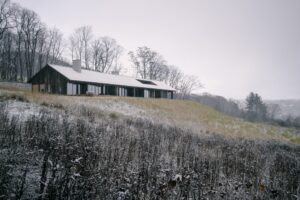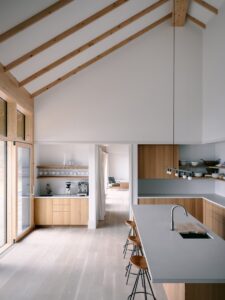Virgin Vineyard House: A Linear House for Intergenerational Living
 Situated between an old logging road and a working hillside vineyard, the Virgin Vineyard House derives its name from a farm whose ruins once stood above the site in North Hatley, Québec, Canada. The client was interested in building a new residence on the land, with minimal disturbance to the vineyard, that would capture views overlooking Lake Massawippi in Quebec’s Eastern Townships. The new building will house the client and provide the ability for her to age in place, as well as to accommodate her daughter’s growing family.
Situated between an old logging road and a working hillside vineyard, the Virgin Vineyard House derives its name from a farm whose ruins once stood above the site in North Hatley, Québec, Canada. The client was interested in building a new residence on the land, with minimal disturbance to the vineyard, that would capture views overlooking Lake Massawippi in Quebec’s Eastern Townships. The new building will house the client and provide the ability for her to age in place, as well as to accommodate her daughter’s growing family.
The design of the project draws inspiration from the prevalence of fieldstone walls in the local agricultural landscape. Gathered stones start as a landscape feature separating the house from the road, ultimately comprising the north wall of the building. The architectural element is but a secondary feature clipped on to this stone wall, sheltering the living spaces from the road, the northerly winds and tucking them into the hillside. The length of the wall enacts the sequence throughout the house, punctuated as it is by compositional events of window, chimney, entry and courtyard. The south side of this long linear residence is open to lake and vineyard views under a large protective overhang.
 This 155’ long house conveniently organizes the private bedrooms at either end, while the central gathering spaces convene in the middle of the linear house. The walls dividing each room are purposefully rotated for views facing the lake. This simple geometrical twist creates an oblique relationship between the rooms and the roof ridge line, making the rooms feel like private sheds, each with its unique volume directed toward the lake.
This 155’ long house conveniently organizes the private bedrooms at either end, while the central gathering spaces convene in the middle of the linear house. The walls dividing each room are purposefully rotated for views facing the lake. This simple geometrical twist creates an oblique relationship between the rooms and the roof ridge line, making the rooms feel like private sheds, each with its unique volume directed toward the lake.
In plan, the rooms are arranged in a sawtooth formation, creating recesses of semi-private spaces under the large roof overhang to contemplate the view. Within this seemingly simple building are two large voids, one being a courtyard framing the angle of the logging road, and the other a roof deck overlooking the entirety of the vineyard.
The building is meant to elucidate a relationship between stone wall and wood tectonics. Aside from the heavily insulated stone wall on the north side, the majority of the construction materials are wood. For the main part of the house, this refers to light wood framing, either with studs, engineered lumber or deep joists. On the south façade, however, wood is employed structurally in the mullions of the wood glazing system, a highly performative envelope with triple glazing throughout.
 Wood construction was of interest in order to keep the embodied energy and carbon footprint down, but also to allow for a well-insulated envelope. Beyond the environmental aspect, the lumber, hemlock cladding, stone and even the high-performance glazing systems were all locally procured in Québec. Even the geothermal ground source heating was not just a “de rigeur” systems choice, but rather a particularly advantageous element in Québec, where plentiful carbon-free municipal electricity can power the heat pumps. Foremost in the architects’ minds was this connection to the location through materials and craft, as well as traditional forms of Québec architecture. The owner is working with a local horticulturalist to plant indigenous flora to support the natural habitat of the site.
Wood construction was of interest in order to keep the embodied energy and carbon footprint down, but also to allow for a well-insulated envelope. Beyond the environmental aspect, the lumber, hemlock cladding, stone and even the high-performance glazing systems were all locally procured in Québec. Even the geothermal ground source heating was not just a “de rigeur” systems choice, but rather a particularly advantageous element in Québec, where plentiful carbon-free municipal electricity can power the heat pumps. Foremost in the architects’ minds was this connection to the location through materials and craft, as well as traditional forms of Québec architecture. The owner is working with a local horticulturalist to plant indigenous flora to support the natural habitat of the site.
Project Team:
Architect: LAMAS Architecture Ltd
Project team: Vivian Lee (architect), James Macgillivray (architect),
Andrea Rodriguez Fos (project manager)
Interior design: LAMAS Architecture Ltd
Landscape: Paysage Lambert and Oscar Hache
Photographer: Felix Michaud
Structural & Civil Engineer: Eric St George Structures et Civile
Mechanical Engineer: Genecor
Contractor: Construction Yves Lessard
Millwork: Ebénisterie Renova

